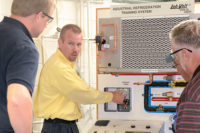“We took nice and pretty and made it more functional,” said Crothers, Fortis’ HVACR program director at the Indianapolis branch. The 60-week program’s revamp is now being reviewed for inclusion in other HVACR programs at Fortis’ dozens of branches in 13 states.
One example is the six-week-long Environmental Protection Agency (EPA) Section 608 certification. Crothers upgraded the program so that interactive CD-ROMs supplement the classroom teaching.
The first modification was expanding from a one-computer/projector classroom to a 20-computer learning lab. Each computer is loaded with the Qwik608™ Pack by Mainstream Engineering (Rockledge, Fla.). Qwik608 is an interactive CD-ROM accompanied by a 12-page self-study booklet and proctored certification. It interactively brings students back to training book pages containing information that corresponds to the questions that were answered incorrectly in practice tests. Crothers requires scores of 21 out of 25 before students can take the official online test at www.epatest.com, which he proctors himself.
“I looked at the existing course syllabus and found it didn’t have an interactive function where students could test themselves after each night of studying,” said Crothers, who had used Mainstream Engineering online certifications personally before joining Fortis. He also uses the CD-ROM to supplement several refrigeration textbooks and hands-on training such as refrigerant recovery and charging.
Voluntary Achievement
Besides the EPA section, the Qwik608 Pack includes free R-410A training/certification as part of its comprehensive Section 608 coverage. It also offers optional training and certification in preventative maintenance tech, green certification, and indoor air quality. Crothers’ framed, office wall-mounted certificates from these programs often inspire students to voluntarily earn other certifications, although they’re not required.
“You can never have too much certification,” Crothers said. “The certificates look like college diplomas, so the students are very proud to achieve them.”
Fortis includes all certifications in the tuition, so the lower upfront cost and free retests of the Qwik608 Pack help contain education costs for both the school and students.
Braving the Elements
Another example of Crothers’ quest toward hands-on experiences is how he has worked around restrictions that previously hindered student training. The local fire codes prohibited the school from operating a walk-in cooler in its fourth-floor office building location. Crothers, however, made the best out of the restriction when setting up a cooler by Louisville Cooler Manufacturing Co. (Louisville, Ky.) for classroom training. Industrial refrigeration students now learn how to assemble the 10 x 10-foot walk-in cooler shell in the classroom, but without its roof, to comply with the fire code. Additionally, the walk-in cooler’s evaporator, which was supplied by Heatcraft Refrigeration Products (Stone Mountain, Ga.) has a compressor in an adjacent classroom that cools the entire classroom to 20° to 32°F. This cold room helps students service the equipment inside in a simulated winter or fall Indianapolis outdoor environment or an unheated basement.
“Students have hands-on HVACR training in a warm classroom, but when they get outdoors they can struggle with the elements,” said Crothers. “It takes a different skill set for brazing or repairing year-round refrigeration equipment under those conditions, and our students now get that experience here.”
Real-Life Situations
Another new hands-on policy is the requirement to disassemble classroom residential equipment and install it all the way back to the circuit breaker, including 220V and 110V connections, and gas piping. Previously, the classroom looked like an open retail showroom. Crothers built walls around each unit to simulate a real-life environment of running utilities, line sets, and ducting through walls and ceilings.
He also endeavors to create an employee scenario with his students when possible. For example, Crothers requires students to fill out morning job tickets for picking a project’s correct accessories from the school’s faux wholesale area.
“We put students in real-life scenarios like sizing replacement components from mixed brands, such as when the repair unit is a Trane and the employer is a Goodman dealer,” he explained. “I see students that are happier because they’re better prepared and more confident.”
www.fortis.edu
855-436-7847
Publication date: 10/17/2011













